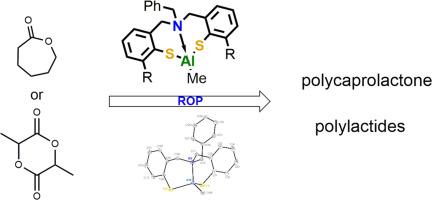New aluminum complexes based on S,N,S-type Aminobisthiophenol Ligands for ring-opening polymerization of lactide and ε-caprolactone
IF 2.1
3区 化学
Q3 CHEMISTRY, INORGANIC & NUCLEAR
引用次数: 0
Abstract
In this work we report the synthesis of new aminobisthiophenol ligands BnN{CH2[(6-R)(2-HS)C6H3]}2, R = H (5a); R = Ph (5b), and also four-coordinated methyl aluminum complexes BnN{CH2[(6-R)(2-S—)C6H3]}2Al—Me, R = H (6a); R = Ph (6b). It was found that ligands of this type, according to 1H and 13C NMR data, as well as X-ray diffraction (for complex 6a), successfully stabilize aluminum complexes in the monomeric form. The composition of the obtained complexes is confirmed by elemental analysis data. X-ray diffraction study of aluminum complex 6a showed that it is four-coordinate species with a distorted trigonal monopyramidal coordination core. Complexes 6a and 6b (in the presence of benzyl alcohol) were studied as initiators of ring opening polymerization (ROP) of ε-caprolactone (ε-CL), rac-lactide (rac-LA), and copolymerization of l-lactide (L-LA) and ε-CL. Complex 6b showed greater activity in ROP of rac-LA ([rac-LA]:[6b]:[BnOH]=100:1:1; full conversion of rac-LA polymerization in toluene solution at 80 °C was achieved after 48 h) and ε-CL ([ε-CL]:[6b]:[BnOH]=100:1:1; full conversion of ε-CL polymerization in toluene solution at 80 °C was achieved after 30 min and at room temperature after 6 h) compared to 6a.

基于S,N,S型氨基双硫酚配体的新型铝配合物开环聚合丙交酯和ε-己内酯
本文报道了新型氨基双硫酚配体BnN{CH2[(6-R)(2- hs)C6H3]}2的合成,R = H (5a);R = Ph (5b)和四配位甲基铝配合物BnN{CH2[(6-R)(2-S -)C6H3]} 2Al-Me, R = H (6a);R = Ph (6b)。根据1H和13C NMR数据,以及x射线衍射(对于配合物6a),发现这种类型的配体成功地稳定了单体形式的铝配合物。所得配合物的组成经元素分析数据证实。对铝配合物6a的x射线衍射研究表明,它是一个具有畸变三角单锥体配位核的四配位物质。以配合物6a和6b为引发剂,研究了ε-己内酯(ε-CL)、rac-丙交酯(rac-LA)和l-丙交酯(L-LA)与ε-CL的开环聚合(ROP)。配合物6b对rac-LA的ROP活性更高([rac-LA]:[6b]:[BnOH]=100:1:1);rac-LA在80℃甲苯溶液中聚合48 h后完全转化),ε-CL ([ε-CL]:[6b]:[BnOH]=100:1:1;与6a相比,在80℃甲苯溶液中,ε-CL聚合在30 min后完全转化,在室温下,6 h后完全转化。
本文章由计算机程序翻译,如有差异,请以英文原文为准。
求助全文
约1分钟内获得全文
求助全文
来源期刊

Journal of Organometallic Chemistry
化学-无机化学与核化学
CiteScore
4.40
自引率
8.70%
发文量
221
审稿时长
36 days
期刊介绍:
The Journal of Organometallic Chemistry targets original papers dealing with theoretical aspects, structural chemistry, synthesis, physical and chemical properties (including reaction mechanisms), and practical applications of organometallic compounds.
Organometallic compounds are defined as compounds that contain metal - carbon bonds. The term metal includes all alkali and alkaline earth metals, all transition metals and the lanthanides and actinides in the Periodic Table. Metalloids including the elements in Group 13 and the heavier members of the Groups 14 - 16 are also included. The term chemistry includes syntheses, characterizations and reaction chemistry of all such compounds. Research reports based on use of organometallic complexes in bioorganometallic chemistry, medicine, material sciences, homogeneous catalysis and energy conversion are also welcome.
The scope of the journal has been enlarged to encompass important research on organometallic complexes in bioorganometallic chemistry and material sciences, and of heavier main group elements in organometallic chemistry. The journal also publishes review articles, short communications and notes.
 求助内容:
求助内容: 应助结果提醒方式:
应助结果提醒方式:


